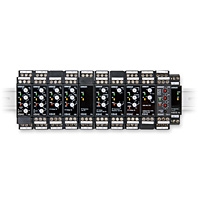K8AK / K8DS Series
Measuring & Monitoring Relays

DIN 22.5/17.5 Size Lineup of A Wide Range of Measuring and Monitoring Relays
last update: July 11, 2013
K8AK-AS Single-phase Current Relay
• Monitor for overcurrents or undercurrents.
• Use commercially available CTs (CT current on secondary side: 0 to 1 A or 0 to 5 A).
• Manual resetting and automatically resetting supported by one Relay.
• Startup lock and operating time can be set separately.
• One SPDT output relay, 5 A at 250 VAC (resistive load).
• Output relay can be switched between normally open and normally closed.
• Output status can be monitored using LED indicator.
• Inputs are isolated from the power supply.
K8AK-AW Single-phase Overcurrent/Undercurrent Relays
• Monitor for overcurrents and undercurrents simultaneously.
Separate settings and outputs supported for overcurrents and undercurrents.
• Use commercially available CTs (CT current on secondary side: 0 to 1 A or 0 to 5 A).
• Manual resetting and automatically resetting supported by one Relay.
• Startup lock and operating time can be set separately.
• Two sets of SPDT output contacts, 5 A at 250 VAC (resistive load).
• Output status can be monitored using LED indicator.
• Inputs are isolated from the power supply.
K8AK-VS Single-phase Voltage Relay
• Monitor for overvoltages or undervoltages.
• Manual resetting and automatically resetting supported by one Relay.
• One SPDT output relay, 5 A at 250 VAC (resistive load).
• Output relay can be switched between normally open and normally closed.
• Process control signal (0 to 10 V) and current splitter input supported.
• Output status can be monitored using LED indicator.
• Input frequency of 40 to 500 Hz supported.
• Inputs are isolated from the power supply.
K8AK-VW Single-phase Overvoltage/Undervoltage Relays
• Monitor for overvoltages and undervoltages simultaneously.
Separate settings and outputs supported for overvoltages and undervoltages.
• Manual resetting and automatically resetting supported by one Relay.
• Pre-alarm Monitoring Mode.
• Two SPDT output relays, 5 A at 250 VAC (resistive load).
• Process control signal (0 to 10 V) and current splitter input supported.
• Output status can be monitored using LED indicator.
• Input frequency of 40 to 500 Hz supported.
• Inputs are isolated from the power supply.
K8DS-PH Phase-sequence Phase-loss Relay
• Lineup includes a 17.5-mm slim, compact model.
• Greater resistance to inverter noise.
• Distinguishes between positive phases, reversed phases, and phase loss when power is turned ON.
• Supports phase loss detection when the motor is operating.
• Output status can be monitored using LED indicator.
• Ideal to prevent reverse operation of motors.
K8AK-PH Phase-sequence Phase-loss Relay
• Greater resistance to inverter noise.
• Distinguishes between positive phases, reversed phases, and phase loss when power is turned ON.
• Supports phase loss detection when the motor is operating.
• 5 A (resistive load) at 250 VAC, DPDT x 1.
• Output status can be monitored using LED indicator.
• Ideal to prevent reverse operation of motors.
K8AK-PW Three-phase Voltage Relay
• Greater resistance to inverter noise.
• Monitor overvoltages and undervoltages for three-phase 3-wire or 4-wire power supplies.
DIP switch setting for 3-phase 3-wire or 3-phase 4-wire power supply.
• Two SPDT output relays, 5 A at 250 VAC (resistive load).
Separate outputs possible for overvoltages and undervoltages.
• World-wide power specifications supported by one Unit (switchable using DIP switch).
• Relay status can be monitored using LED indicator.
K8AK-PM Three-phase Phase-sequence Phase-loss Relay
• Greater resistance to inverter noise.
• Monitor overvoltages, undervoltages, phase sequence, and phase loss for three-phase 3-wire or 4-wire power supplies with just one Unit.
Switch setting for 3-phase 3-wire or 3-phase 4-wire power supply.
• Two SPDT output relays, 5 A at 250 VAC (resistive load).
Output overvoltages and undervoltages using separate relays.
• World-wide power specifications supported by one Unit (switchable).
• Output status can be monitored using LED indicator.
K8AK-PA Three-phase Asymmetry and Phase-sequence Phase-loss Relay
• Greater resistance to inverter noise.
• Monitor voltage asymmetry, phase sequence, and phase loss for three-phase 3-wire or 4-wire power supplies with just one Unit.
Switch setting for 3-phase 3-wire or 3-phase 4-wire power supply.
• One SPDT output relay, 5 A at 250 VAC (resistive load).
• World-wide power specifications supported by one Unit (switchable).
• Relay status can be monitored using LED indicator.
K8AK-TH Temperature Monitoring Relay
• Excessive temperature increases can be prevented and abnormal temperatures can be monitored.
• Temperature monitoring in slim design with a width of just 22.5 mm.
• Rotary switches simplifies temperature settings.
• Universal-input support for thermocouple or platinum resistance thermometer sensor input.
• Change the output relay between normally open and normally closed operation.
• Alarm status identification with LED indicator.
• Self-holding output.
K8AK-LS Conductive Level Controller
• Self-holding ON or OFF outputs can be selected using selfholding circuit.
• Sensitivity adjustment of operating resistance from 10 to 100 kΩ for application to a wide range of liquids.
• Prevents chattering of relay contacts that occurs with ripples.
• Easy wiring with ferrules.
• Use 2 × 2.5 mm2 solid wire or 2 × 1.5 mm2 ferrules.
• Applicable as a floatless switch.
last update: July 11, 2013

